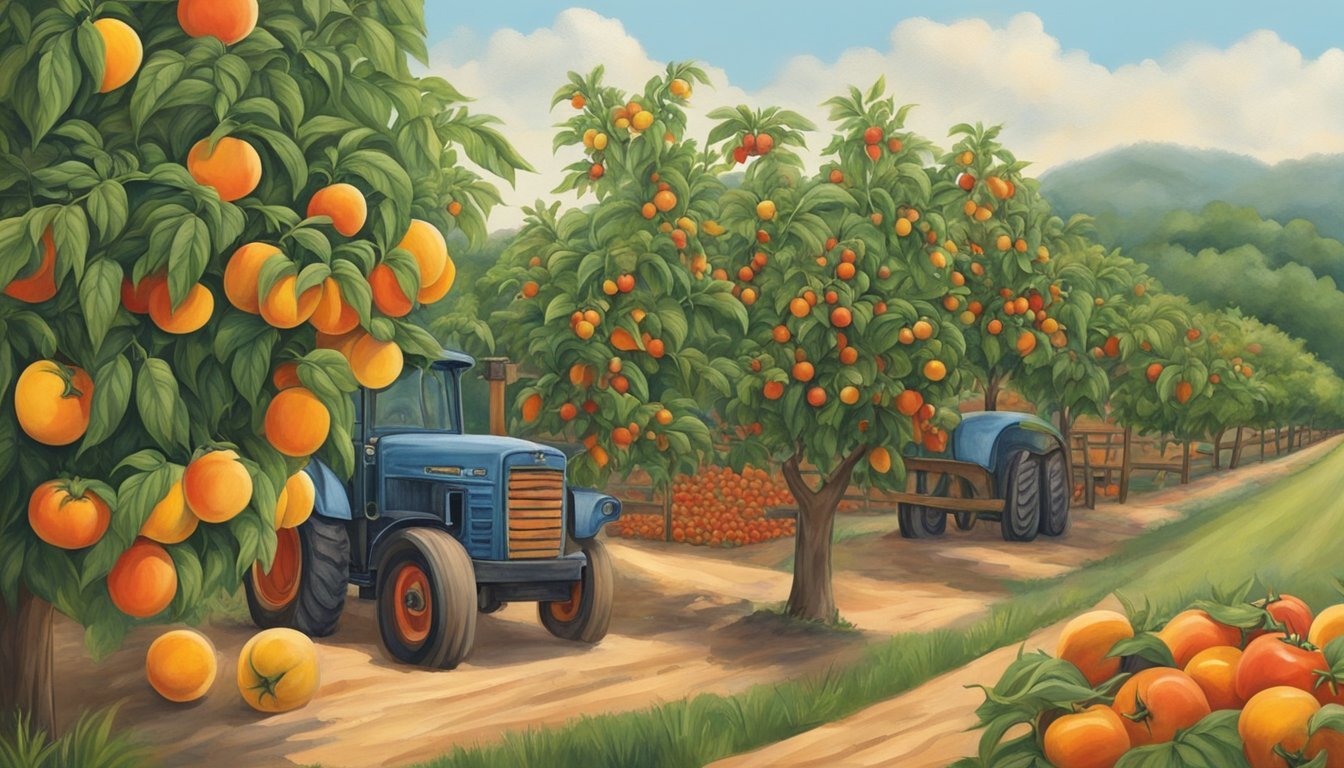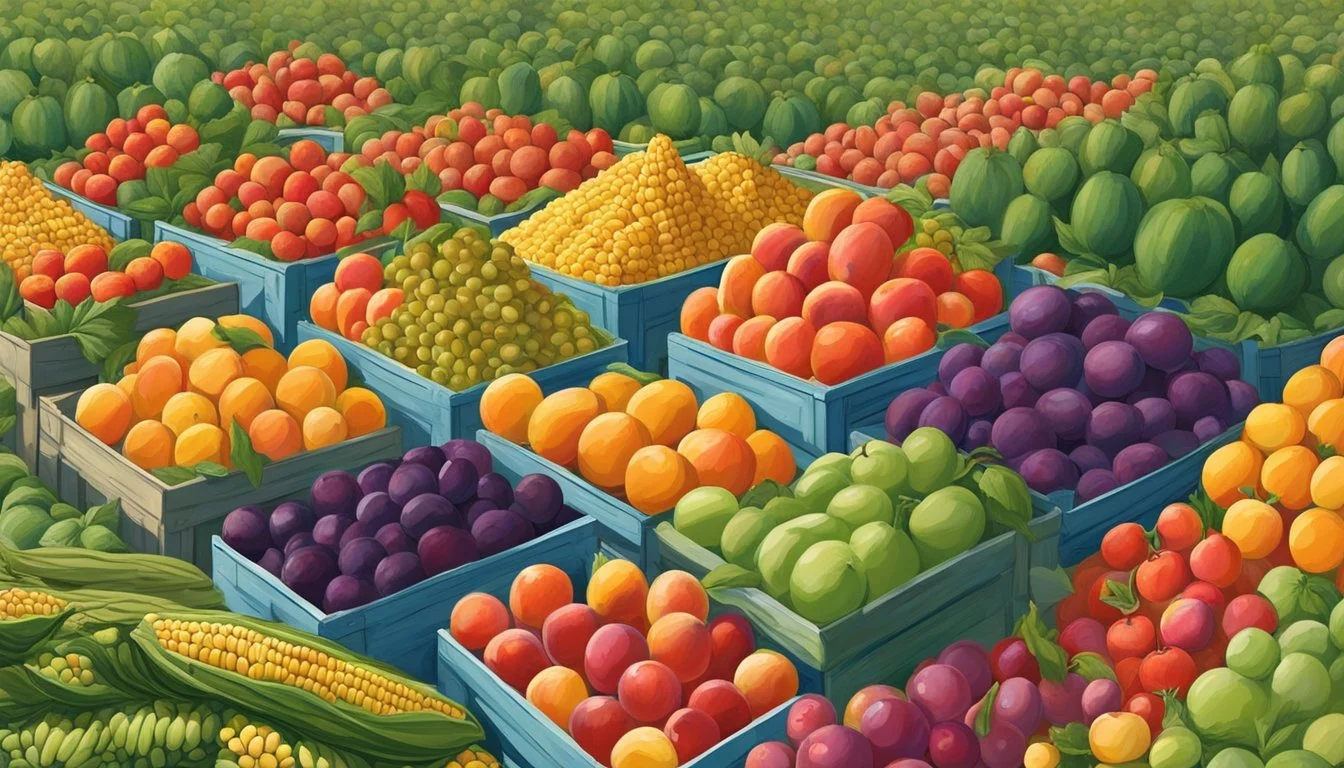Alabama Seasonal Fruit & Vegetables in August
Your Fresh Guide
This Article is Part of our Alabama Seasonal Fruit & Veg Calendar
August in Alabama marks a transitional period in the agricultural calendar, as the state's farmers and gardeners harvest the last of summer's bounty and prepare for the onset of fall's offerings. This month, the warm and humid climate of Alabama continues to support a variety of fruits and vegetables. Late-summer produce such as watermelons, cantaloupes (how long does cantaloupe last?), and peaches provide a sweet farewell to the summer, while the fields are also abundant with a colorful assortment of tomatoes (What wine goes well with tomatoes?), corn, okra, and peppers.
As the summer season reaches its peak, Alabama's gardens and orchards are lush with produce, drawing both local consumers and visitors to farmers' markets and roadside stands. These markets become showcases for the state's agricultural richness—a testament to the diversity of crops that thrive in the Southern soil. The staples of Alabama's August harvest not only reflect the state's agricultural prowess but also its culinary traditions, which are steeped in the use of fresh, seasonal ingredients.
Transitioning towards fall, Alabama gardeners begin to plant the seeds of autumnal crops. Farmers anticipate the upcoming season by preparing for the planting of greens, such as collards and turnips, that will reach maturity in the cooler days ahead. The shift from summer to fall is gradual, allowing gardeners to extend the life of their summer gardens while simultaneously welcoming the start of a new growing season.
Seasonal Foods Overview in Alabama
As August brings the heat of summer to Alabama, the state's agricultural bounty is ripe for harvest. The warm climate and long growing season result in a variety of fruits and vegetables reaching peak maturity.
Fruits Available in August
Watermelon: Its high water content and sweet flavor make it a staple for summer refreshment.
Harvest: Peak season is in full swing in August.
Climate Impact: Heat aids in sugar development and size.
Peaches, Blueberries, Blackberries (how long do blackberries last?): All these fruits enjoy the warm weather and are typically ready to be picked.
In Season: Continuing from early summer, these fruits are sweet and plentiful.
Fruit Harvest Status Peaches In full harvest Blueberries Nearing end of season Blackberries In full harvest
Vegetables Harvest in August
Tomatoes, Cucumbers, Eggplant (What wine goes well with eggplant?), Okra: These heat-loving crops thrive in the summer warmth, contributing to a robust harvest.
Planting: Often planted in spring to mature in summer.
Watering: Consistent watering is crucial in high temperatures.
Vegetable Harvest Status Tomatoes Abundant availability Cucumbers Ready for harvest Eggplant (What wine goes well with eggplant?) In season Okra Harvest continues
Leafy Greens & Herbs Selection
Kale, Collards, Swiss Chard: Even in the heat, these greens are harvested, though they are less abundant than in cooler months.
Weather: Preference for cooler weather, but still available.
Harvest: Picked early or late in the day to ensure freshness.
Parsley, Mustard: (how long does mustard last?) These hardy herbs persist through the summer heat.
Harvest: Regularly cut to encourage growth.
Use: Often used fresh in dishes for their flavor.
Greens & Herbs Note Kale Less common in heat, still found Collards Available but prefers the cold Swiss Chard Harvested during cooler times of the day Parsley Consistent harvest Mustard Cut and come again method used
Health Benefits and Nutritional Information
Eating seasonally provides the opportunity to consume fruits and vegetables at their peak nutritional value. August in Alabama brings a bounty of such produce, each with distinct health benefits and nutrient profiles.
Fruit Nutritional Profiles
Seasonal fruits harvested in Alabama during August are packed with vitamins, minerals, and antioxidants. For instance:
Watermelon: Rich in vitamins A and C, it also contains a powerful antioxidant called lycopene, which is linked to heart health and cancer prevention.
Cantaloupe: A great source of vitamin A in the form of beta-carotene and vitamin C, cantaloupe helps support immune function and skin health.
Peaches: Provide dietary fiber, vitamin C, and contain a variety of minerals including potassium.
These fruits contribute to healthy eating by offering a spectrum of nutrients essential for the body's overall functioning.
Vegetable Health Advantages
Vegetables available in August come with an array of health advantages. They are high in fiber and low in calories, supporting a healthy diet and aiding in digestion. Key nutritional characteristics include:
Dark Green Vegetables: Such as spinach and kale are high in iron, calcium, and vitamins A, C, E, and K.
Roots and Tubers: Including sweet potatoes and carrots, these vegetables offer high levels of beta-carotene, vitamin C, and provide a good source of fiber.
Consumption of these vegetables contributes to a balanced nutrition, offering essential minerals and vitamins while promoting overall health.
Gardening Tips for August in Alabama
August in Alabama is a transitional period where gardeners must adapt their practices to accommodate the hot, humid conditions of late summer, while preparing for the onset of cooler fall weather. This section provides localized advice to help ensure a bountiful harvest throughout the changing seasons.
Utilizing Alabama's Diverse Climate
Alabama's climate ranges from the humid subtropical conditions of the south to the more temperate zones in the north. In August, gardeners should consider Alabama Gardener’s Calendar recommendations, which suggest that different gardening activities may be required depending on their location within the state. For instance, the northern regions might start to experience an earlier transition to fall-like conditions. Kerry Smith and Frances Sledge, horticulture experts from the Alabama Cooperative Extension System, advise tailoring your gardening schedule to your specific regional climate.
Soil Preparation and Maintenance
Soil quality forms the foundation of any successful garden. Soil testing is imperative to determine nutrient needs and pH levels. Amendments like compost can be added to improve soil structure and fertility. Mulching is essential to conserve water, regulate soil temperature, and reduce weed competition. Gardeners such as Dave Williams suggest using organic mulch to add nutrients back into the soil as it decomposes.
Planting Strategies for Late Summer
Late summer is an ideal time to begin planting crops that will thrive in Alabama's fall climate. Beans and squash are among the vegetables suitable for late summer planting because they have a relatively short time to maturity. Ron Shumack, an Alabama gardening authority, recommends considering indoor plantings of some vegetables to get a head start on the fall growing season. Fertilizing should be done sparingly this month, especially for certain grass varieties; it is advised to skip fertilizing centipedegrass and zoysiagrass in August. Pruning should be performed carefully to avoid stimulating new growth that can be damaged by early fall frosts.
Culinary Uses and Recipes
August in Alabama brings a bounty of fruits and vegetables, each lending itself to a variety of culinary uses. From sweet peaches and watermelons to a range of hearty vegetables, locals enjoy a palette of fresh ingredients that can be transformed into traditional dishes or innovative creations.
Seasonal Fruit Recipes
Peaches: Alabama peaches in August are ripe for baking. They can be sliced and used in classic peach cobblers or grilled peach salads. The natural sweetness of the fruit is enhanced when caramelized, which makes it perfect for desserts.
Watermelons: With their refreshing juice and sweet flavor, watermelons are ideal for watermelon sorbet or chilled watermelon gazpacho. One can also add feta cheese and mint for a quick watermelon salad.
Berries: Blackberries are abundant in this month. They can be used in blackberry jams or blackberry pies. Their vibrant flavor stands out in simple, rustic pastries that showcase Alabama tradition.
Vegetable-Based Dishes
Squash and Eggplants: Squash and eggplants offer a robust base for many dishes. They can be featured in stuffed squash, baked eggplant parmesan (What wine goes well with eggplant parmesan?), or ratatouille (What wine goes well with ratatouille?), all of which encapsulate the full flavor of August produce.
Peppers and Tomatoes: Peppers range from sweet to spicy, making them versatile. Stuffed bell peppers (What wine goes well with stuffed bell peppers?) or tomato salsa are traditional dishes that highlight the fresh, crisp taste. Heirloom tomatoes can shine in a simple tomato salad dressed with olive oil and salt.
Herbs and Seasoning Pairings
Parsley: Fresh parsley pairs well with tomatoes, providing a bright, herby flavor to tomato-based sauces and salads.
Mustard Greens: These can be sautéed with garlic and olive oil to complement squashes or eggplants, or used raw in salads to add a peppery bite.
By focusing on the freshest ingredients, Alabama's August harvest can be showcased through simple yet flavorful dishes that pay homage to Southern culinary traditions.
Sustainable Practices and Local Economies
Alabama's agricultural sector has made significant strides in sustaining local economies through the promotion of seasonal fruits and vegetables. The state's efforts in local farming and markets have shown a commitment to sustainable practices that benefit the local community.
Supporting Alabama Farmers
Local farmers in Alabama are at the core of the state's economy, generating over $100 million in value-added production. By focusing on seasonal produce, farmers optimize crop yields and align with local demand, ensuring freshness and reducing waste. Consumers who purchase locally grown products contribute to a healthier economy by keeping money within the community. For instance, each dollar spent at local markets has a positive ripple effect, with a considerable portion circulating back into Alabama's regional economy.
Economic Impact: $2 million in indirect business taxes from the industry.
Job Creation: 1,121 jobs generated through fruit, vegetable, and tree nut agriculture.
Environmental Benefits of Seasonal Eating
Eating seasonally in Alabama not only supports sustainability within the state's agriculture sector but also benefits the environment. Local farming practices work to maintain the land through safe and sustainable methods. Seasonal produce travels shorter distances to local markets, reducing carbon emissions and promoting a more sustainable food system.
Transportation: Lowered carbon footprint due to reduced travel for local produce.
Land Use: Sustainable agricultural practices maintain and improve soil health.
Educational Resources and Events
August in Alabama offers a ripe opportunity for those interested in the season’s offerings of fruits and vegetables to increase their knowledge and participate in community events that celebrate agriculture and gardening.
Workshops and Farmers Markets
Workshops: The Alabama Cooperative Extension System frequently hosts workshops that help both beginners and experienced gardeners improve their skills. Topics often include gardening techniques, seasonal planting advice, and preserving the harvest. For August, participants may find sessions that focus on late-summer crop management and preparation for the fall harvest. Auburn University, a key player in agricultural education, may also offer specialized workshops in agriculture and horticulture during this time.
Farmers Markets: Throughout the state, farmers markets become vibrant community hubs, especially in August when many fruits and vegetables reach peak season. These markets not only allow consumers to purchase fresh, locally-grown produce like tomatoes, peaches, and melons, but they often also provide educational booths or events. Such initiatives may include cooking demonstrations, nutritional information, and tips for growing one's own garden. The Alabama Farmer's and Consumer's Bulletin serves as a resource for locating markets and related events.
Publications and Online Resources
Publications: The Alabama Gardener's Calendar is a comprehensive guide available to those interested in learning about gardening and seasonal horticulture. Published by institutions such as the Alabama Cooperative Extension, it provides month-by-month advice on planting, maintenance, and harvesting.
Online Resources: Alabama Extension’s website offers a wealth of online articles and guides that focus on everything from the specifics of vegetable gardening to the broader aspects of agricultural education. This selection is augmented during peak seasons with relevant content to help enthusiasts and professionals alike make the most of the harvest. The Sweet Grown Alabama program provides additional resources, which include educational videos and worksheets, particularly useful for teachers and students looking to integrate agriculture education into their curriculum.
By tapping into these workshops, markets, and online resources, individuals in Alabama can enrich their understanding and appreciation for the state's bountiful seasonal produce and vibrant agricultural community.







